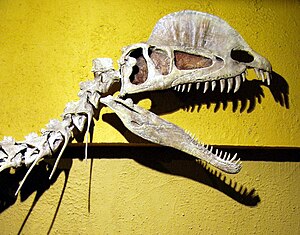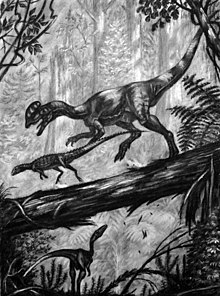Dilophosaurus
| Dilophosaurus | ||||||||||||
|---|---|---|---|---|---|---|---|---|---|---|---|---|

Dilophosaurus skull reconstruction at Canada's Royal Tyrrell Museum |
||||||||||||
| Temporal occurrence | ||||||||||||
| Lower Jurassic ( Sinemurian ) | ||||||||||||
| 199.3 million years | ||||||||||||
| Locations | ||||||||||||
|
||||||||||||
| Systematics | ||||||||||||
|
||||||||||||
| Scientific name | ||||||||||||
| Dilophosaurus | ||||||||||||
| Welles , 1970 | ||||||||||||
| species | ||||||||||||
|
||||||||||||
Dilophosaurus ( Greek "two-chambered lizard") is a genus of theropod dinosaur that lived during the early Lower Jurassic ( Sinemurium ).
The type species Dilophosaurus wetherilli has been identified from the Kayenta formation in the south-west of the USA . However, there are also fossil indications of a distribution of the genus in Eurasia , for example through the not generally recognized species Dilophosaurus sinensis from the People's Republic of China .
description

Dilophosaurus , like its relatives, was lightly built. With an average length of six meters, it probably weighed only 500 kilograms. His neck was long and slender. The head, with large windows in the skull, was also lightweight. In addition, part of the upper jaw was bent forward like a hook. Of the remaining theropods, only a few other coelophysoids and spinosaurs had this feature . Due to its light body and long hind limbs, it was probably a fast, agile predatory dinosaur that might hunt its prey in a sprint . Its teeth were narrow and long and not suitable for hunting large prey. Instead, it is believed that Dilophosaurus preyed on smaller dinosaurs like Scutellosaurus , or that it used its clawed extremities to hunt larger dinosaurs. Another theory suggests that Dilophosaurus preferred fish as its food. The anatomical similarity of its skull with that of the piscivorous spinosaurids seems to confirm this assumption.
The most striking thing about Dilophosaurus was probably the two eponymous bone ridges on its head. They were too thin and delicate to be used as weapons. On the other hand, as gender-specific features, they could have been conspicuously colored and played a role in courtship , for example in showing off against rivals or in courtship . This theory is supported by the fact that some individuals have smaller ridges ( gender dimorphism ).
Discovery and species
At the end of the summer of 1942, a research group led by Samuel Paul Welles , led by a Navajo Indian, recovered the remains of a predatory dinosaur in the Painted Desert of Arizona not far from Tuba City . These fossils were initially assigned to the genus Megalosaurus and described as the new species Megalosaurus wetherilli . After the discovery of another specimen near the first site in 1969, it became clear that the species differed significantly from Megalosaurus : The new specimen clearly had two large longitudinal ridges on the back of the snout. Because of this anatomical peculiarity, Welles established a new genus in 1970, which he aptly named Dilophosaurus . He changed the name of the species accordingly to Dilophosaurus wetherilli .

Two other species were later described, D. breedorum and D. sinensis . The Asian Dilophosaurus sinensis had larger skull windows and much more stable teeth compared to Dilophosaurus wetherilli and is now regarded as a synonym of Sinosaurus . The classification of D. breedorum as an independent species is also controversial, as this species would only differ slightly from D. wetherilli , especially in size, shape and double crest.
Footprints ascribed to Dilophosaurus were discovered in northern Italy, among other places, on Monte Buso .
Systematics
Dilophosaurus is the eponymous and best-known member of the controversial Dilophosauridae family . In the past, Dilophosaurus was often seen as the link between the ceratosaurs and the coelurosaurs . Current studies, however, see a basal neotheropod outside of Ceratosauria and Tetanurae in the genus . There it is partially placed in the Coelophysoidea , but in other works it is combined with other basal neotheropods to form the Dilophosauridae family.
Cladogram according to Smith et al. (2007).
| Neotheropoda |
|
||||||||||||||||||||||||||||||||||||||||||
|
|
Abbreviated cladogram based on Hendrickx and Mateus (2014).
| Theropoda |
|
|||||||||||||||||||||||||||||||||
|
|
Cladogram according to Hendrickx et al. (2015).
| Neotheropoda |
|
|||||||||||||||||||||||||||||||||||||||||||||||||||
|
|
Popular culture
Dilophosaurus appears in the novel Jurassic Park by Michael Crichton and the film Jurassic Park . In the film, Dilophosaurus shown as poison-breathing beast that has a abspreizbare neck frill, similar to today's frilled lizard . However, there is no scientific evidence for either the poison spitting or the ruff. Furthermore, Dilophosaurus is shown in the film much smaller than it corresponds to the facts.
Individual evidence
- ^ Samuel P. Welles: New Jurassic dinosaur from the Kayenta Formation of Arizona . In: Bulletin of the Geological Society of America. Vol. 65, 1954, pp. 591-598, doi : 10.1130 / 0016-7606 (1954) 65 [591: NJDFTK] 2.0.CO; 2
- ^ Dilophosaurus Discovered. Dilophosaurus ! A Narrated Exhibition. University of California Museum of Paleontology (UCMP), Berkeley, 1994-2005, accessed November 17, 2007
- ↑ a b Dilophosaurus details. Dilophosaurus ! A Narrated Exhibition. University of California Museum of Paleontology (UCMP), Berkeley, 1994-2005, accessed November 17, 2007
- ^ Samuel P. Welles: Dilophosaurus (Reptilia: Saurischia), a New Name for a Dinosaur. In: Journal of Paleontology. Vol. 44, No. 5, 1970, p. 989, JSTOR
- ↑ LiDa Xing, Phil R. Bell, Bruce M. Rothschild, Hao Ran, JianPing Zhang, ZhiMing Dong, Wei Zhang, Philip J. Currie : Tooth loss and alveolar remodeling in Sinosaurus triassicus (Dinosauria: Theropoda) from the lower jurassic strata of the Lufeng Basin, China. In: Chinese Science Bulletin. Vol. 58, No. 16, 2013, ISSN 1001-6538 , pp. 1931-1935, doi : 10.1007 / s11434-013-5765-7 .
- ^ Matthew T. Carrano, Roger BJ Benson, Scott D. Sampson: The phylogeny of Tetanurae (Dinosauria: Theropoda). In: Journal of Systematic Palaeontology. Vol. 10, No. 2, 2012, ISSN 1477-2019 , pp. 211-300, doi : 10.1080 / 14772019.2011.630927 .
- ^ ND Smith, PJ Makovicky, D. Pol, WR Hammer, PJ Currie: The Dinosaurs of the Early Jurassic Hanson Formation of the Central Transantarctic Mountains: Phylogenetic Review and Synthesis. In: US Geological Survey and The National Académies. 2007, doi : 10.3133 / of2007-1047.srp003.
- ↑ Christophe Hendrickx, Octávio Mateus: Torvosaurus gurneyi n. Sp., The Largest Terrestrial Predator from Europe, and a Proposed Terminology of the Maxilla Anatomy in Nonavian Theropods. In: PLoS ONE. Vol. 9, No. 3, 2014, ISSN 1932-6203 , p. E88905, doi : 10.1371 / journal.pone.0088905 .
- ↑ HC. endrickx, SA Hartman, O. Mateus: An Overview of Non-Avian Theropod Discoveries and Classification. In: PalArch's Journal of Vertebrate Palaeontology. 12 (1), 2015, pp. 1–73.
- ^ J. Bret Bennington: Errors in the Movie "Jurassic Park". In: American Paleontologist. Vol. 4, No. 2, 1996, ISSN 1066-8772 , pp. 4-7 ( online ).
Web links
- Dilophosaurus ! A Narrated Exhibition - Illustrated representation of Dilophosaurus with original audio commentary bythe discoverer Samuel Welles.
